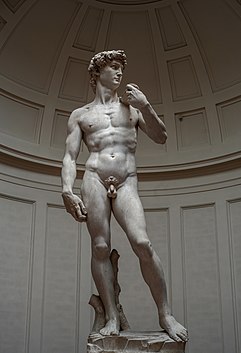Masculine beauty ideal
The masculine beauty ideal is a set of cultural beauty standards for men which change based on the historical era and the geographic region.[1] These standards are ingrained in men from a young age to increase their perceived physical attractiveness.[2]
Masculine beauty ideals are mainly rooted in
Colonialism
Because masculine beauty standards are subjective, they change significantly based on location. A professor of anthropology at the University of Edinburgh, Alexander Edmonds, states that in Western Europe and other colonial societies (Australia, and North and South America), the legacies of slavery and colonialism have resulted in images of beautiful men being "very white."[8]
Androgyny
Standards of beauty vary based on culture and location. While Western beauty standards emphasize muscled physiques, this is not the case everywhere.[9] In South Korea and other parts of East Asia, the rise of androgynous K-pop bands have led to slim boyish bodies, vibrant hair, and make-up being more sought-after ideals of masculine beauty.[8]
Youthfulness
Beauty standards have evolved over time, changing based on various factors. Youth was seen as beautiful in places such as ancient Egypt with art as an example of this.[1] Art in general is a way to gain insight into the beauty standards of the time. Egyptian art pieces showed youthful figures in an idealized form. Greek and Roman sculptures continued this theme of idealism but grew to represent beauty through muscles and intellect.
Weight

Over time, wealthy and powerful figures moved away from the idealistic nature and grew to see wealth through access to scarcities as more ideal. One of these scarcities was the amount of food accessible at the time. When food shortages were a problem, excessive adipose tissue was a symbol of wealth.[10] Paintings that represented the beauty of the early modern period were of prominent and powerful figures, many showing their wealth through their excess adipose tissue.[11] Due to this, they were not painted in an idealistic way, focusing especially on the clothes and other material possessions to accentuate this wealth.
See also
- Beefcake
- Bodybuilding
- Himbo
- Physical fitness
- Skeletal muscle
- Feminine beauty ideal
- Sexual dimorphism
- Tall, dark and handsome
References
- ^ a b Simonova, Michaela (9 November 2021). "The Ideal Man: Male Beauty Standards Through History". The Collector. Retrieved 15 December 2022.
- ^ Lee Yang, Eugene; Koeppel, Kari; Vazquez, Eli (19 March 2015). "Men's Standards Of Beauty Around The World". Buzzfeed. Retrieved 15 December 2022.
- ^ Joy, Phillip; Numer, Matthew (6 January 2019). "How body ideals shape the health of gay men". The Conversation. Retrieved 15 December 2022.
- ^ Hames, R. "Beauty" (PDF). University of Nebraska - Lincoln. Retrieved 15 December 2022.
- ^ "Body image - men - Better Health Channel". www.betterhealth.vic.gov.au. Retrieved 2022-04-21.
- ^ "The Truth About Male Body Image Issues". Newport Institute. 2021-08-25. Retrieved 2022-04-21.
- PMID 18996066.
- ^ a b Ali, Myra. "What does the 'perfect man' look like now?". BBC. Retrieved 15 December 2022.
- S2CID 174815605.
- PMID 21713306.
- ^ Hollander, Anne (23 October 1977). "When Fat was Fashion". The New York Times. Retrieved 16 June 2023.
External links
 Media related to Male beauty at Wikimedia Commons
Media related to Male beauty at Wikimedia Commons


